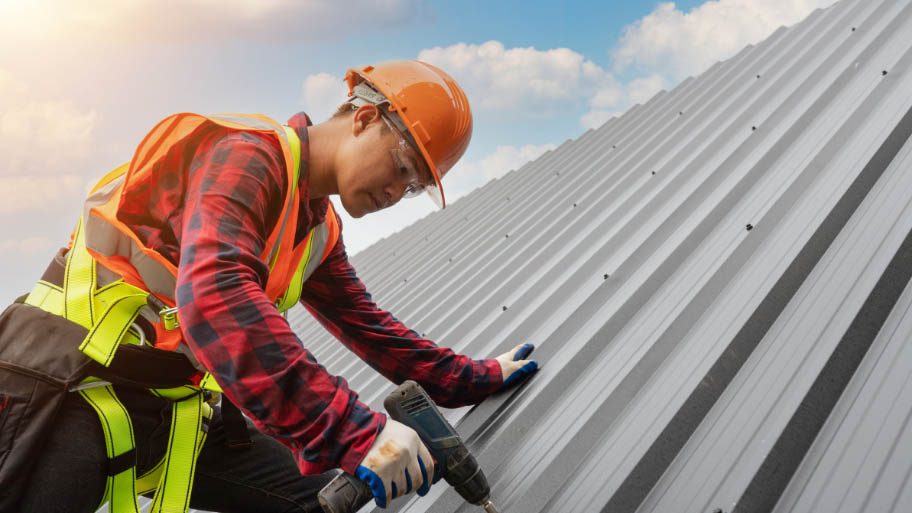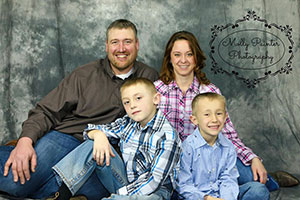When it comes to maintaining your home in Perry, IA, overlooking the significance of roofing safety can be all too easy.. But here’s the thing – adhering to essential roofing safety tips isn’t just about avoiding injuries; it’s about protecting your home’s very structure.
Every year, far too many homeowners face unnecessary risks by underestimating the dangers associated with roof work, with falls being a particularly grim statistic leading the pack. That’s why it’s crucial to arm yourself with knowledge and practices that keep you and your roof safe.

Roof safety is all about taking the right precautions to ensure that everyone involved in roof maintenance or repair tasks is protected from potential hazards. It encompasses a range of practices—from wearing the correct personal protective equipment to knowing how to safely navigate the roof’s surface.
By understanding what roof safety really means, you’re setting a foundation for preventing accidents. It’s not just about avoiding falls; it’s about creating an environment where safety is prioritized at every step.
This knowledge empowers homeowners to approach roofing tasks with confidence and caution, ensuring that their home improvement projects are carried out without putting anyone at risk.
As homeowners, our roofs shelter us from the elements, yet working on them exposes us to a variety of risks. Understanding these hazards is the first step toward ensuring the safety of anyone brave enough to scale our homes’ summits.
The most glaring threat comes from the potential for falls, a risk compounded by sloped surfaces and unpredictable footing. The key to prevention lies in proper planning and equipment.
Before any work begins, assessing the roof for stability and potential hazards is crucial. Employing safety measures such as guardrails, personal fall arrest systems (PFAS), and safety nets can drastically reduce the risk.
Additionally, ensuring that all individuals working on the roof have undergone safety training reinforces a culture of safety and vigilance.
Electricity poses a silent threat to roofers, particularly when ladders, tools, or the body come into contact with overhead power lines.
The use of non-conductive ladders, maintaining a safe distance from power lines, and wearing insulated gloves and footwear are all preventative steps that can save lives.
Awareness and caution are your allies against electrical hazards.
While power tools are indispensable for efficiency, they bring their own set of dangers, including cuts, abrasions, and even projectiles.
Regular maintenance of tools, along with the use of protective gear such as goggles and gloves, minimizes these risks.
It’s also vital to ensure that all users are competent with the tools they’re using, with clear guidelines on their proper use and storage.
Roofing involves the use of materials that can be harmful if not handled correctly. From tar and asphalt to solvents and adhesives, knowing the proper handling and disposal methods is critical.
This includes wearing appropriate protective clothing, ensuring good ventilation, and following the manufacturer’s safety instructions to the letter.
Weather conditions can turn a roof into an oven under the summer sun or an ice rink in winter. Taking precautions against heatstroke and hypothermia is as important as the physical work itself.
This means scheduling work during cooler parts of the day, wearing suitable clothing, and staying hydrated or warm.
When tackling roof work, the right safety gear isn’t just important—it’s essential. From secure footwear to protective headgear and the indispensable safety harness, each piece plays a crucial role. Let’s dive into these key items, ensuring you’re well-equipped for safety and confidence at every step.
Imagine your footwear as the base of everything you do up high. On a roof, the right pair of shoes or boots becomes your anchor to the world below.
Seek out footwear that boasts anti-slip soles designed to clutch tightly to the surface beneath you, providing a firm stance and a sense of security with each move you make.
This gear isn’t only for dodging slip-ups; it’s about moving with assurance and trust in your stride.
Your head deserves the best protection out there. A hard hat isn’t just another accessory; it’s a critical shield against whatever may come your way, from unexpected bumps to falling debris.
Choose one that’s comfortable enough for all-day wear but tough enough to meet safety standards. It’s like a helmet for your high-flying adventures, ensuring you stay safe as you soar.
If there’s one piece of equipment you can’t afford to skip, it’s the safety harness. This isn’t just gear; it’s your personal guardian angel, ready to catch you if you fall.
A well-fitted harness tethered to a sturdy anchor point is non-negotiable for roof work. It’s not just about preventing falls; it’s about the freedom to work with confidence, knowing you’re covered from every angle.
By gearing up with these essentials, you’re not just meeting safety standards — you’re putting your well-being first. This isn’t about ticking boxes for the sake of regulations; it’s about ensuring that every moment spent on the roof is as safe as it is productive.
Let’s make safety the foundation of every project, building a secure environment where you can focus on the task at hand, knowing you’re fully protected.
Ladder safety isn’t just a step in roof work; it’s the foundation that everything else builds upon. Let’s ensure you’re set up for success from the ground up.
It all starts with selecting a ladder that matches the job:
A ladder that’s too short or not sturdy enough isn’t just inconvenient, it’s a risk. Opt for one that extends at least 3 feet over the roofline for stability and easy access.
Place your ladder on solid, level ground, ensuring it’s fully extended and locked in place. A 1:4 ratio for placement—every 4 feet in height means 1 foot away from the wall—helps maintain balance.
Always face the ladder while climbing, keeping hands free and carrying tools in a belt or pouch. Maintain three points of contact at all times. Once up, avoid overreaching or leaning too far to one side; move the ladder instead.
Incorporating these practices ensures not just personal safety but also the quality and efficiency of your work on the roof.
Adhering to roof safety best practices isn’t just about compliance; it’s about ensuring a secure and efficient work environment from start to finish. This section explores critical steps and considerations, from checklists to clothing, to keep safety at the forefront of roofing work.
Before any work begins, a comprehensive safety checklist can be a game-changer. This list should cover equipment checks, identifying potential hazards, and ensuring all safety gear is in place and correctly used. It acts as a final walkthrough to ensure nothing is overlooked.
It’s vital to map out pathways on the roof that steer clear of any potential dangers, creating a safe route for movement.
These designated lanes are key to minimizing the risk of accidents, particularly in spots that see a lot of movement. Implementing visible markings or setting up temporary guides can help navigate workers safely and efficiently.
The unpredictability of weather plays a significant role in roofing safety. It’s wise to delay any roofing activities when faced with conditions like gusty winds, precipitation, or extreme hot or cold temperatures.
Scheduling tasks during more stable weather not only prioritizes safety but can also lead to better outcomes in your roofing endeavors.
What you wear on the roof matters. Opt for clothing that protects against the elements and potential hazards while allowing for comfortable movement.
This includes long sleeves, durable pants, gloves, and eye protection. Your outfit should shield you from the sun, sharp objects, and other risks without restricting mobility.
If you’re diving into roofing work around Perry, IA, or its surrounding areas, understanding when to call in the experts is key. Here, we’ll walk you through recognizing those times, stressing the value of partnering with a local roofing pro who puts safety first.
There are clear signs that indicate a roofing project might be too complex or hazardous for a DIY approach. These include:
If the job poses a risk to your safety or the integrity of your home, it’s time to consult with experts.
Opting for a seasoned professional ensures your roofing project is handled with the utmost safety and quality in mind. When tasks go beyond DIY territory, turning to experts who prioritize safety is key.
This decision not only enhances your roof’s longevity but also safeguards everyone involved. For trusted, safety-first roofing solutions in Perry, IA, consider reaching out to Affordable Quality Exteriors. Let us bring peace of mind and excellence to your roofing needs.
Expanding on roofing safety, here are ten frequently asked questions to guide you through both the basics and the specifics of staying safe.
Always use a hard hat, anti-slip footwear, and a safety harness with a lifeline for comprehensive protection.
Inspect your gear before every use to catch any potential wear or damage.
No, it’s best to avoid roofing in wet conditions to prevent slipping. Wait for a clear, dry day.
Solo work is risky; however, if necessary, ensure someone is aware of your project and can check on you periodically.
Use an extension ladder that extends at least 3 feet past the roof edge, securely anchored and on stable ground.
Anchor the base and top of the ladder, and use a stabilizer bar for extra security.
Different roofing materials require specific safety approaches. Always research or consult a professional for guidance on your specific roof type.
Immediately stop working and carefully descend. Reassess the safety measures and seek professional advice if necessary.
Yes, avoid roofing in high winds. If caught unexpectedly, secure loose materials and descend safely.
Keep your work area clean and free of loose tools or materials, establish clear walkways, and use guardrails or safety nets if possible.
These FAQs aim to cover a wide range of concerns, ensuring you’re well-prepared for a safe roofing project.
As we bring our journey through roofing safety to a close, let’s quickly recap the essentials that safeguard your projects from start to finish.
As we conclude our guide to roofing safety, it’s clear that whether you’re a DIY enthusiast or a professional in Perry, IA, or its neighboring communities, embracing these safety tips is essential.
Embracing these tips not only ensures the longevity of your roof but also protects the most valuable asset involved in any project: the people. Remember, a successful roofing project is one that brings everyone safely back to the ground.

Billy Lee Heinkel II is the heart and soul of Affordable Quality Roofing & Exteriors in Perry, Iowa. With a rich experience spanning over 20 years, Billy and his skilled team specialize in roofing, siding, and other exterior services. They’re known for their top-quality work and dedication to customer satisfaction. Billy’s strong ethics and focus on excellent service ensure every project is handled with care, delivering outstanding results for all their clients’ exterior needs.